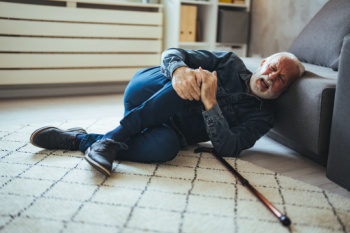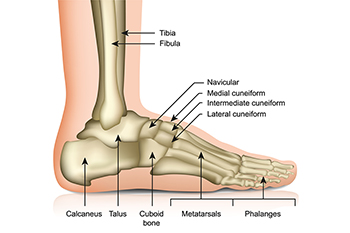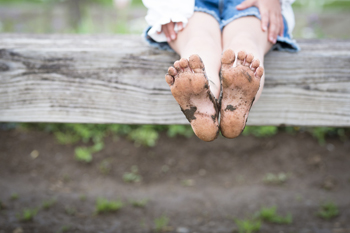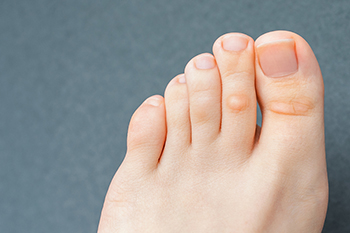Connect With Us
Blog
Items filtered by date: December 2024
The Impact of Falling on the Feet and How to Prevent Injuries

Falling can significantly affect the feet, leading to injuries such as sprains, fractures, or bruises. When a person falls, the feet often bear the brunt of the impact, which can cause immediate pain and long-term complications. Several risk factors contribute to falls, including poor balance, weak muscles, slippery surfaces, and wearing improper footwear. People with certain health conditions, like diabetes or poor vision, may also face a higher risk of falling. To prevent falls and foot injuries, it is important to maintain good balance through exercises that strengthen the lower body. Wearing well-fitted, supportive shoes with non-slip soles can reduce the likelihood of slipping. Keeping living areas free of obstacles and ensuring proper lighting can also help minimize fall risks. If you have endured foot injuries from falling, it is suggested that you contact a podiatrist who can educate you about effective fall prevention techniques.
Preventing falls among the elderly is very important. If you are older and have fallen or fear that you are prone to falling, consult with Edward Orman, DPM from Honeygo Podiatry. Our doctor will assess your condition and provide you with quality advice and care.
Every 11 seconds, an elderly American is being treated in an emergency room for a fall related injury. Falls are the leading cause of head and hip injuries for those 65 and older. Due to decreases in strength, balance, senses, and lack of awareness, elderly persons are very susceptible to falling. Thankfully, there are a number of things older persons can do to prevent falls.
How to Prevent Falls
Some effective methods that older persons can do to prevent falls include:
- Enrolling in strength and balance exercise program to increase balance and strength
- Periodically having your sight and hearing checked
- Discuss any medications you have with a doctor to see if it increases the risk of falling
- Clearing the house of falling hazards and installing devices like grab bars and railings
- Utilizing a walker or cane
- Wearing shoes that provide good support and cushioning
- Talking to family members about falling and increasing awareness
Falling can be a traumatic and embarrassing experience for elderly persons; this can make them less willing to leave the house, and less willing to talk to someone about their fears of falling. Doing such things, however, will increase the likelihood of tripping or losing one’s balance. Knowing the causes of falling and how to prevent them is the best way to mitigate the risk of serious injury.
If you have any questions, please feel free to contact our offices located in Perry Hall, and Fallston, MD . We offer the newest diagnostic and treatment technologies for all your foot care needs.
Do Your Child's Feet Hurt?
Preventing Ankle Sprains in Basketball Players

Ankle sprains are a common injury among basketball players due to the high-intensity movements such as quick direction changes, jumping, and landing. These actions put significant stress on the ankle ligaments, increasing the risk of spraining the ankle. Weak or imbalanced muscles surrounding the ankle joint and poor conditioning can make players more vulnerable. To prevent ankle sprains, strengthening exercises like the single leg calf raise help improve stability and strengthen the calves, which support the ankle. Single leg ladder drills can enhance coordination, agility, and ankle stability, helping players react quickly and safely during movements. The plate raise exercise targets the muscles of the lower legs and feet, enhancing balance and joint support. If you have endured an ankle injury while playing basketball, it is suggested that you contact a podiatrist who can treat various foot and ankle injuries, and guide you on additional injury prevention tips.
Sports related foot and ankle injuries require proper treatment before players can go back to their regular routines. For more information, contact Edward Orman, DPM of Honeygo Podiatry. Our doctor can provide the care you need to keep you pain-free and on your feet.
Sports Related Foot and Ankle Injuries
Foot and ankle injuries are a common occurrence when it comes to athletes of any sport. While many athletes dismiss the initial aches and pains, the truth is that ignoring potential foot and ankle injuries can lead to serious problems. As athletes continue to place pressure and strain the area further, a mild injury can turn into something as serious as a rupture and may lead to a permanent disability. There are many factors that contribute to sports related foot and ankle injuries, which include failure to warm up properly, not providing support or wearing bad footwear. Common injuries and conditions athletes face, including:
- Plantar Fasciitis
- Plantar Fasciosis
- Achilles Tendinitis
- Achilles Tendon Rupture
- Ankle Sprains
Sports related injuries are commonly treated using the RICE method. This includes rest, applying ice to the injured area, compression and elevating the ankle. More serious sprains and injuries may require surgery, which could include arthroscopic and reconstructive surgery. Rehabilitation and therapy may also be required in order to get any recovering athlete to become fully functional again. Any unusual aches and pains an athlete sustains must be evaluated by a licensed, reputable medical professional.
If you have any questions please feel free to contact our offices located in Perry Hall, and Fallston, MD . We offer the newest diagnostic and treatment technologies for all your foot and ankle needs.
Facts About Foot Stress Fractures

Stress fractures are hairline cracks in bones caused by repetitive stress rather than a sudden injury. Stress fractures, which are common among runners and athletes like basketball players, frequently affect the metatarsals, heel bone, and other weight-bearing bones in the foot and ankle. Symptoms of stress fractures usually start as mild pain during activity and gradually worsen, potentially leading to discomfort, even at rest. Contributing factors include sudden increases in activity levels, wearing improper footwear, or poor bone health. A podiatrist can diagnose stress fractures through imaging tests like MRI scans, as they are difficult to detect with X-rays. Treatment often involves using a walking boot or cast to immobilize the area and allow the bone to heal. In some cases, crutches may be necessary to reduce weight-bearing. A podiatrist can provide guidance on preventing future fractures by addressing footwear, activity modification, and proper nutrition for bone health. If you have foot pain caused by stress fractures, it is suggested that you schedule an appointment with a podiatrist for an exam and treatment.
Activities where too much pressure is put on the feet can cause stress fractures. To learn more, contact Edward Orman, DPM from Honeygo Podiatry. Our doctor can provide the care you need to keep your pain free and on your feet.
Dealing with Stress Fractures of the Foot and Ankle
Stress fractures occur in the foot and ankle when muscles in these areas weaken from too much or too little use. The feet and ankles then lose support when walking or running from the impact of the ground. Since there is no protection, the bones receive the full impact of each step. Stress on the feet can cause cracks to form in the bones, thus creating stress fractures.
What Are Stress Fractures?
Stress fractures occur frequently in individuals whose daily activities cause great impact on the feet and ankles. Stress factors are most common among:
- Runners
- People affected with Osteoporosis
- Tennis or basketball players
- Gymnasts
- High impact workouts
Symptoms
Pain from the fractures occur in the area of the fractures and can be constant or intermittent. It will often cause sharp or dull pain with swelling and tenderness. Engaging in any kind of activity which involves high impact will aggravate pain.
If you have any questions please feel free to contact our offices located in Perry Hall, and Fallston, MD . We offer the newest diagnostic and treatment technologies for all your foot and ankle needs.
Barefoot Walking in PreSchool Children

Allowing children to walk barefoot until the age of four is beneficial for both brain and body development. Walking without shoes promotes natural foot growth, helping to strengthen muscles and improve balance. It also enhances the sensory experience by allowing the feet to feel different textures and surfaces, which aids in the development of the brain’s sensory pathways. These early experiences help children develop coordination and spatial awareness, important skills for future movement. Barefoot walking also encourages proper posture and alignment, as the feet can move freely, engaging muscles that are vital for walking, running, and jumping. Furthermore, by spending time without shoes, children become more aware of their environment, improving their ability to navigate different terrains. If your child has a foot condition, it is suggested that you contact a podiatrist who can offer effective treatment solutions, and address any concerns you may have about your child walking barefoot.
Making sure that your children maintain good foot health is very important as they grow. If you have any questions, contact Edward Orman, DPM of Honeygo Podiatry. Our doctor can provide the care you need to keep you pain-free and on your feet.
Keeping Children's Feet Healthy
Having healthy feet during childhood can help prevent medical problems later in life, namely in the back and legs. As children grow, their feet require different types of care. Here are some things to consider...
Although babies do not walk yet, it is still very important to take care of their feet.
Avoid putting tight shoes or socks on his or her feet.
Allow the baby to stretch and kick his or her feet to feel comfortable.
As a toddler, kids are now on the move and begin to develop differently. At this age, toddlers are getting a feel for walking, so don’t be alarmed if your toddler is unsteady or ‘walks funny’.
As your child gets older, it is important to teach them how to take care of their feet.
Show them proper hygiene to prevent infections such as fungus.
Be watchful for any pain or injury.
Have all injuries checked by a doctor as soon as possible.
Comfortable, protective shoes should always be worn, especially at play.
If you have any questions please feel free to contact our offices located in Perry Hall, and Fallston, MD . We offer the newest diagnostic and treatment technologies for all your foot and ankle needs.
Managing Corns or Calluses

Corns and calluses are common foot conditions that develop due to friction and pressure on the skin. Corns are small, hardened areas of skin that typically form on the top or sides of toes, while calluses are thicker patches of skin that usually appear on the soles of the feet. Both conditions are the body’s natural response to protect itself from rubbing or pressure, often caused by wearing ill-fitting shoes, abnormal gait, or high-impact activities. Symptoms include thickened skin, tenderness, pain when walking, and in some cases, redness or inflammation. While mild treatments like padding or foot creams might help, improper removal can worsen the condition. A podiatrist can provide safe, effective treatment by carefully trimming corns and calluses, recommending custom orthotics to alleviate pressure, and offering advice on proper footwear. If you have persistent foot discomfort, or if corns or calluses are affecting your daily life, it is suggested that you schedule an appointment with a podiatrist for expert care and relief.
Corns can make walking very painful and should be treated immediately. If you have questions regarding your feet and ankles, contact Edward Orman, DPM of Honeygo Podiatry. Our doctor will treat your foot and ankle needs.
Corns: What Are They? And How Do You Get Rid of Them?
Corns are thickened areas on the skin that can become painful. They are caused by excessive pressure and friction on the skin. Corns press into the deeper layers of the skin and are usually round in shape.
Ways to Prevent Corns
There are many ways to get rid of painful corns such as:
- Wearing properly fitting shoes that have been measured by a professional
- Wearing shoes that are not sharply pointed or have high heels
- Wearing only shoes that offer support
Treating Corns
Although most corns slowly disappear when the friction or pressure stops, this isn’t always the case. Consult with your podiatrist to determine the best treatment option for your case of corns.
If you have any questions please feel free to contact our offices located in Perry Hall, and Fallston, MD . We offer the newest diagnostic and treatment technologies for all your foot and ankle needs.
Blog Archives
- March 2025
- February 2025
- January 2025
- December 2024
- November 2024
- October 2024
- September 2024
- August 2024
- July 2024
- June 2024
- May 2024
- April 2024
- March 2024
- February 2024
- January 2024
- December 2023
- November 2023
- October 2023
- September 2023
- August 2023
- July 2023
- June 2023
- May 2023
- April 2023
- March 2023
- February 2023
- January 2023
- December 2022

